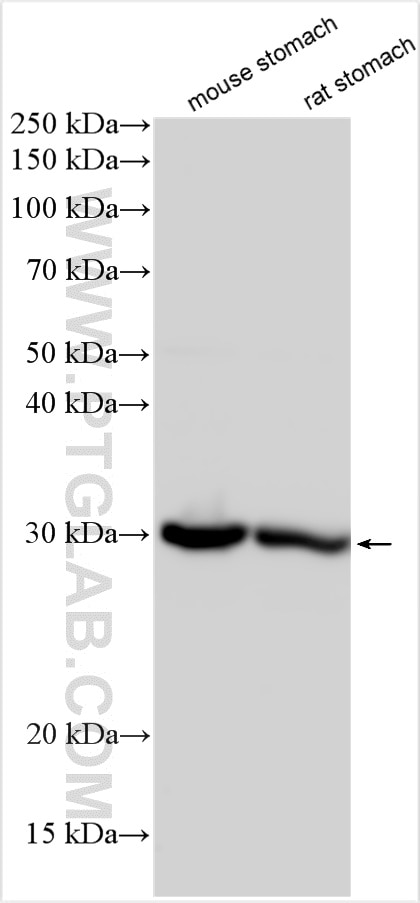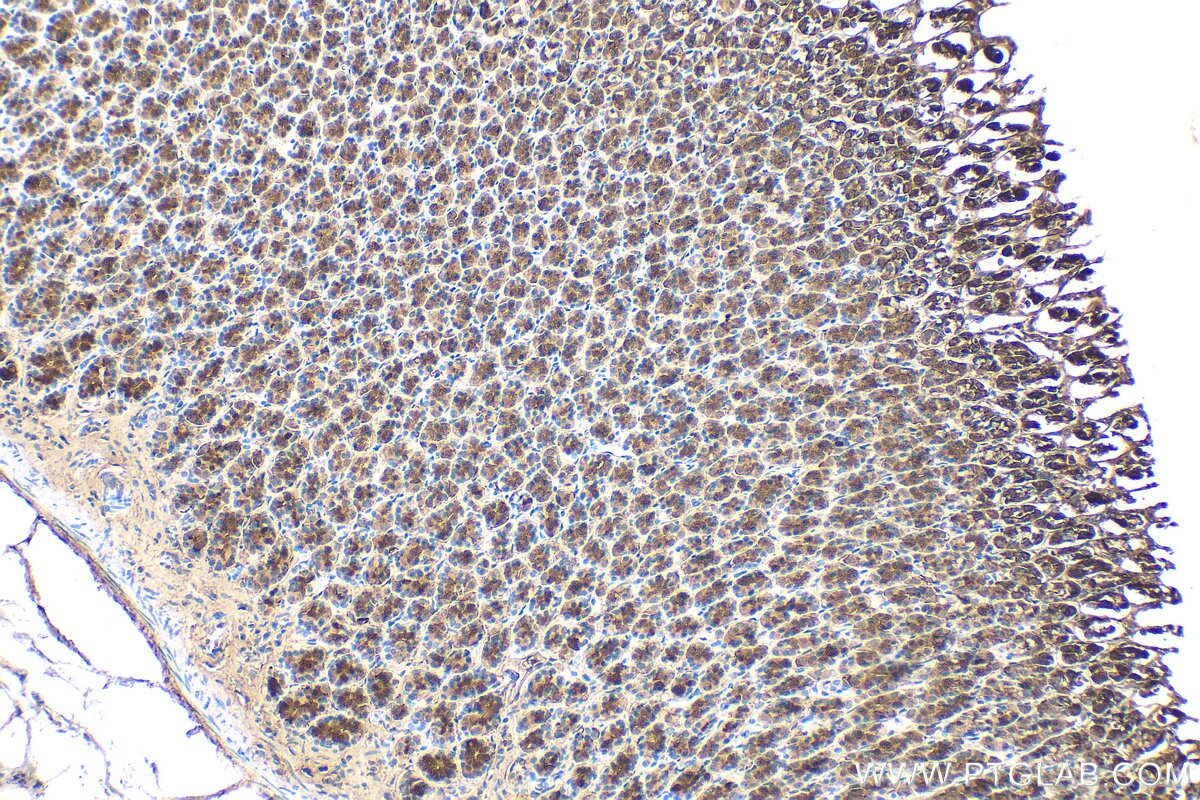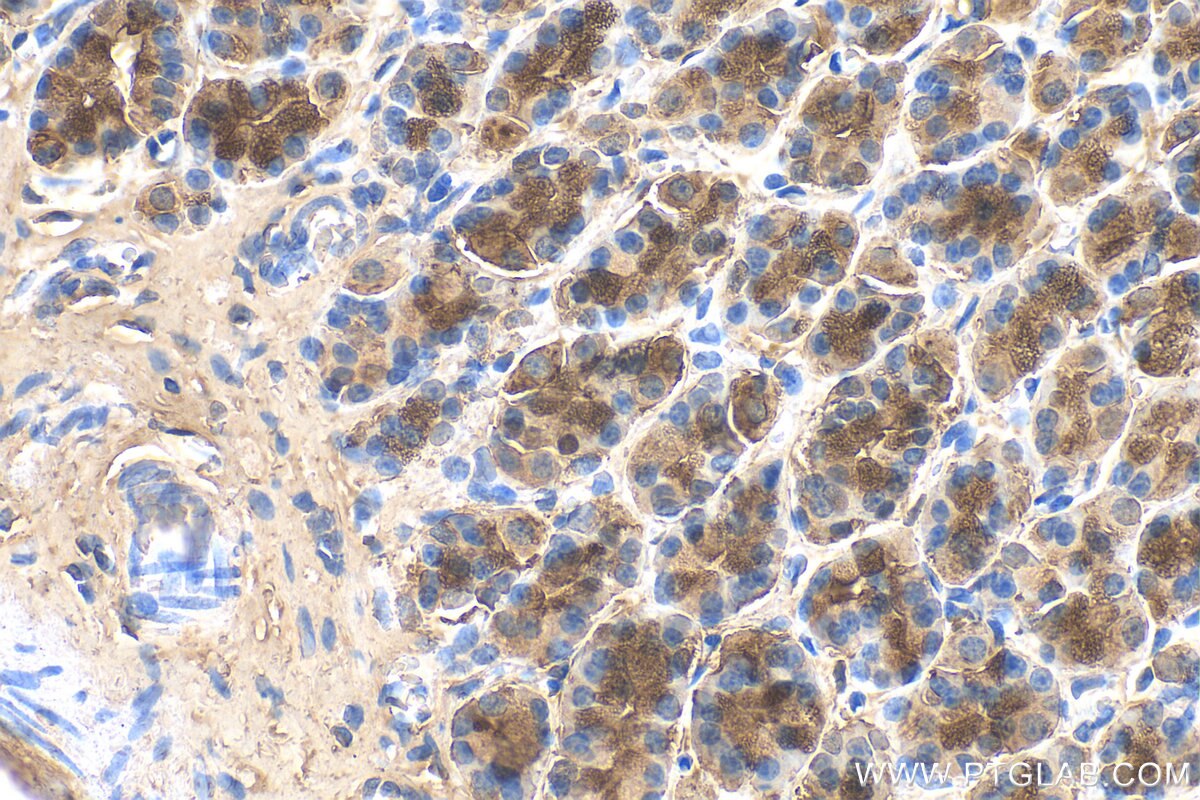ANXA10 Polyklonaler Antikörper
ANXA10 Polyklonal Antikörper für WB, IHC, ELISA
Wirt / Isotyp
Kaninchen / IgG
Getestete Reaktivität
human, Maus, Ratte
Anwendung
WB, IHC, ELISA
Konjugation
Unkonjugiert
Kat-Nr. : 27783-1-AP
Synonyme
Geprüfte Anwendungen
| Erfolgreiche Detektion in WB | Maus-Magengewebe, Ratten-Magengewebe |
| Erfolgreiche Detektion in IHC | Ratten-Magengewebe Hinweis: Antigendemaskierung mit TE-Puffer pH 9,0 empfohlen. (*) Wahlweise kann die Antigendemaskierung auch mit Citratpuffer pH 6,0 erfolgen. |
Empfohlene Verdünnung
| Anwendung | Verdünnung |
|---|---|
| Western Blot (WB) | WB : 1:2000-1:12000 |
| Immunhistochemie (IHC) | IHC : 1:50-1:500 |
| It is recommended that this reagent should be titrated in each testing system to obtain optimal results. | |
| Sample-dependent, check data in validation data gallery | |
Produktinformation
27783-1-AP bindet in WB, IHC, ELISA ANXA10 und zeigt Reaktivität mit human, Maus, Ratten
| Getestete Reaktivität | human, Maus, Ratte |
| Wirt / Isotyp | Kaninchen / IgG |
| Klonalität | Polyklonal |
| Typ | Antikörper |
| Immunogen | ANXA10 fusion protein Ag27094 |
| Vollständiger Name | annexin A10 |
| Berechnetes Molekulargewicht | 37 kDa |
| Beobachtetes Molekulargewicht | 30 kDa |
| GenBank-Zugangsnummer | BC007320 |
| Gene symbol | ANXA10 |
| Gene ID (NCBI) | 11199 |
| Konjugation | Unkonjugiert |
| Form | Liquid |
| Reinigungsmethode | Antigen-Affinitätsreinigung |
| Lagerungspuffer | PBS with 0.02% sodium azide and 50% glycerol |
| Lagerungsbedingungen | Bei -20°C lagern. Nach dem Versand ein Jahr lang stabil Aliquotieren ist bei -20oC Lagerung nicht notwendig. 20ul Größen enthalten 0,1% BSA. |
Hintergrundinformationen
ANXA10 (annexin A10) is a member of the annexin family, and its biological effects are mediated primarily through the calcium-dependent phospholipid-binding and calcium ion binding. ANXA10 is frequently found to be highly expressed in human oral cancer, and this high expression may promote G1 phase cell cycle progression by activating the ERK/MAPK signalling pathway, which in turn results in the reduced expression of member-dependent kinases of cell cycle proteinsn and proliferation. While ANXA10 plays a diverse role in different tumours, in hepatocellular carcinoma, the overexpression of ANXA10 significantly promotes apoptosis. Conversely, in papillary thyroid cancer, the knockdown of ANXA10 promotes apoptosis by inhibiting the MAPK/ERK signalling pathway through the downregulation of TSG101 (PMID: 36936694).
Protokolle
| PRODUKTSPEZIFISCHE PROTOKOLLE | |
|---|---|
| WB protocol for ANXA10 antibody 27783-1-AP | Protokoll herunterladen |
| IHC protocol for ANXA10 antibody 27783-1-AP | Protokoll herunterladenl |
| STANDARD-PROTOKOLLE | |
|---|---|
| Klicken Sie hier, um unsere Standardprotokolle anzuzeigen |




